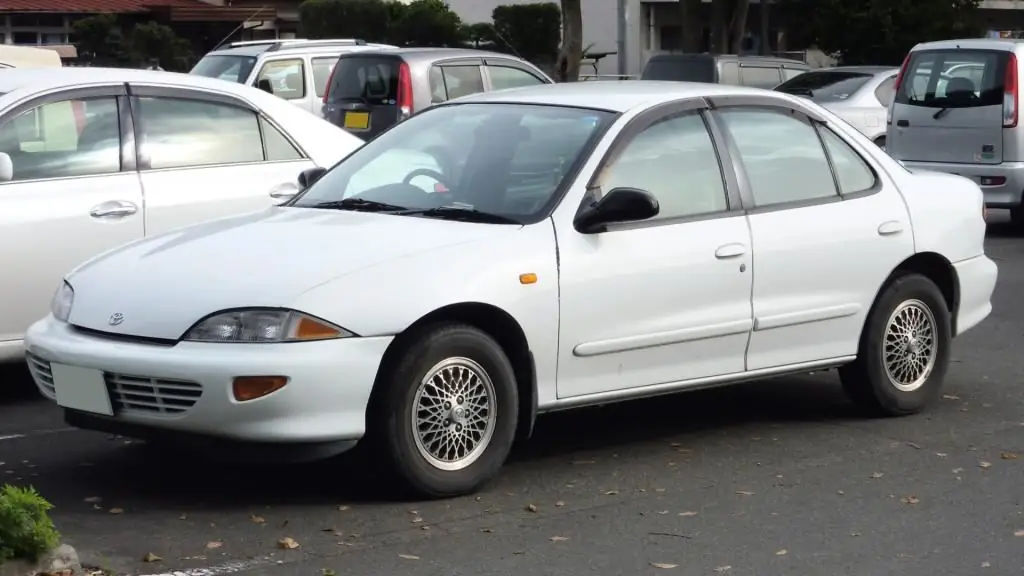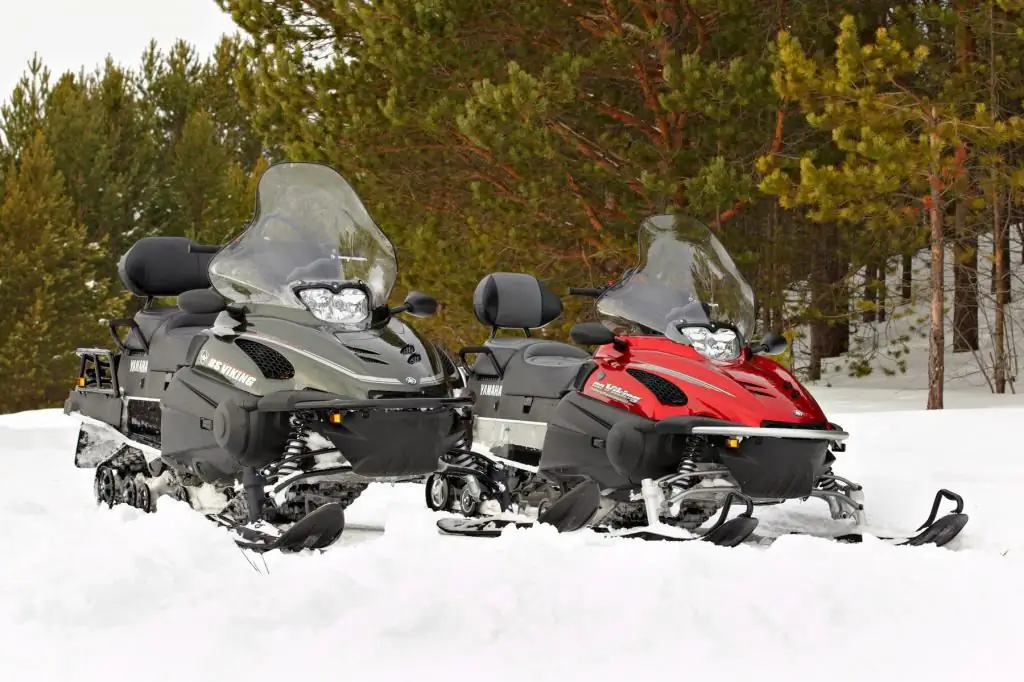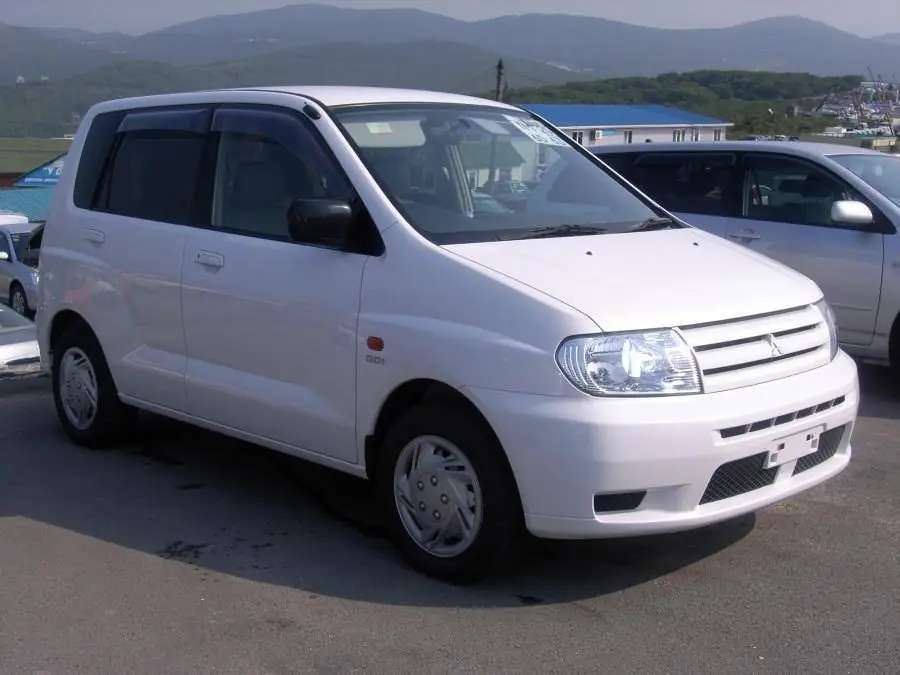2025 Author: Erin Ralphs | [email protected]. Last modified: 2025-01-22 21:14:17
Subcompact cars are very popular in the domestic car market of Japan due to the peculiarities of the tax policy. Specific Japanese cars of this type include subcompact minivans. In terms of size and interior layout, they are similar to class B hatchbacks, but differ in higher body height and enhanced transformation capabilities. One of these models is the Mitsubishi Dingo. The following are the features and specifications of the car, owner reviews about it.
General Features
The model in question was produced from 1998 to 2003 with an update in 2000. Since 2001, the car began to be produced in China under the name Hafei Saima.

Platform, body
Mitsubishi Dingo is built on the Mirage platform. The design of the car is similar to the Dion. Before restyling, it looked very unusual, thanks to the front with vertical headlights. After the update, Mitsubishi Mirage Dingo received a more traditional design. Body dimensions are 3,885-3,92 m long, 1,695 m wide, 1,62-1,635 m high. Wheelbase is 2.44m, curb weight - 1, 17-1, 28 t.

Engines
The model in question was equipped with 4-cylinder 16-valve engines. Mitsubishi Dingo originally had only one motor. Later, two more engines were offered.
4G15. 1.5L DOCH engine equipped with GDI. Its power is 105 hp. With. at 6000 rpm, torque - 140 Nm at 3500 rpm. Initially, Dingo was produced only with this motor

4G13. This is a 1.3L engine with a SOCH cylinder head. Its performance is 80 liters. With. at 5000 rpm and 118 Nm at 3000 rpm

4G93. 1.8L DOCH motor, representing the most powerful option for Dingo. Develops 135 hp. With. at 6000 rpm and 181 Nm at 3750 rpm

Transmission
Mitsubishi Dingo has a front-wheel drive layout. There was also an all-wheel drive option available for the 4G15. Initially, the car was equipped only with a 4-speed automatic transmission INVECS-II. After restyling for 4G15, they began to use the INVECS-III variator.
Chassis
Mitsubishi Dingo received both independent suspensions: front - McPherson type, rear - multi-link. Brakes - disc, ventilated on the front axle, drum - rear. The Dingo was fitted with 14" wheels in sizes 185/65, 175/70 and 15" 195/55 for the most powerful version.
Interior
Dingo salon has a traditional 5-seater two-row layout. The rear row of seats canbe presented as a one-piece sofa in the initial configuration, and divided in half in the higher version. In the second case, each fragment is equipped with an individual longitudinal adjustment. In addition, the rear seat folds down, unfolds into beds and is dismantled to create a cargo compartment.

The location of the gearshift lever on the panel and the lack of a central tunnel provides free space between the front seats. The design, as well as for the exterior, is borrowed from Dion. When restyling, it was slightly updated.

Cost
Mitsubishi Dingo for almost the entire period of production was offered exclusively in the domestic market, where it competed with models such as Nissan Cube, Honda Capa, Mazda Demio. The price of a car in the secondary market currently starts at about 100 thousand rubles and reaches 250-280 thousand
Reviews
Dingo satisfies many owners with performance. Its advantages include compactness, maneuverability, roomy and comfortable interior, visibility, efficiency, comfort and stability on the go, patency due to a flat bottom, unpretentiousness. As disadvantages, poor sound insulation, windage, low ground clearance, insufficient performance of 4G13 are noted. To some, the trunk of the Mitsubishi Dingo seems small. Reviews about suspension stiffness, as well as about reliability, are contradictory.
This car is characterized by problems with the hydraulic booster, steering rack, electronics. The most problematic Dingo node is considered 4G15. This engine is demanding on fuel quality and maintenance, so many problems (increased fuel consumption, significant loss of performance, knocking of hydraulic lifters, etc.) are often observed, up to and including failure due to improper operation.
On 4G13 the valves need to be adjusted. Also, Dingo owners mention cold start difficulties. There have been cases of corrosion on the thresholds, bottom and rear arches. Due to the rarity of the model, it is difficult to find spare parts for it. In addition, most components require original parts that have to be purchased to order. This results in a relatively expensive service.
CV
Mitsubishi Dingo with its compact class B hatchback is characterized by a spacious interior with extensive transformation possibilities. The 4G15 engine is considered the most problematic unit of the model due to the demands on fuel quality and maintenance. There are also problems with steering and electronics. The rest of the car is very unpretentious. Due to the rarity of the Dingo, it is difficult to find parts for it.
Recommended:
Toyota Cavalier: features, specifications, features

Toyota Cavalier is a slightly redesigned Chevrolet model of the same name for the Japanese market. It is a bright and trouble-free car, characterized by an unusual design, good dynamics, reliability and economy. Despite this, it did not gain popularity in the Japanese market for economic reasons and due to the fact that it was inferior to local cars in terms of quality
Mitsubishi Space Gear: features, specifications, reviews

Mitsubishi Space Gear is represented by an off-road minivan. It is highly regarded for its versatility and is almost unparalleled. This car is very reliable and unpretentious, but it has a number of weaknesses
"Yamaha Raptor 700": technical specifications, engine power, maximum speed, features of operation and care, reviews and owner reviews

Japanese company Yamaha, specializing in the development and production of motorcycles, is not limited to motorcycles and develops scooters, snowmobiles and ATVs. One of the best ATVs of the Japanese company is the all-terrain vehicle "Yamaha Raptor 700"
"Yamaha Viking Professional": technical specifications, engine power, maximum speed, operation and maintenance features, reviews and owner reviews

"Yamaha Viking Professional" - a real heavy snowmobile, designed to conquer mountain slopes and snowdrifts. From the curves of the front bumper to the roomy rear luggage compartment, the Yamaha Viking Professional literally speaks of its utility snowmobile
Snowmobile "Dingo 150": reviews and specifications

Modern snowmobile is a specialized vehicle designed to move through the snow. They are used in various spheres of human activity and are necessary for the possibility of safe and fast movement in various snowy areas

